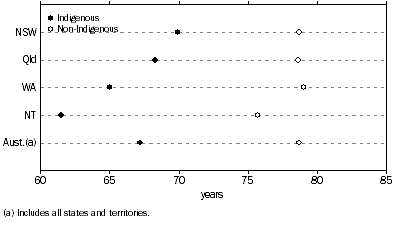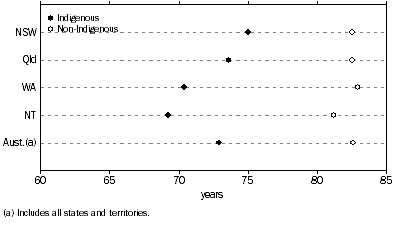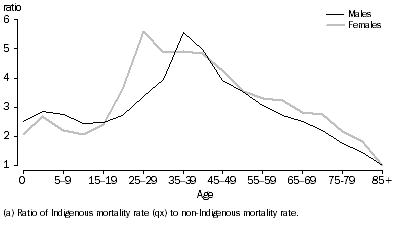NOTES
ABOUT THIS RELEASE
This publication presents experimental life tables for male and female Aboriginal and Torres Strait Islander Australians for the reference period 2005-2007, for New South Wales, Queensland, Western Australia, the Northern Territory and Australia.
CHANGE IN METHOD
As foreshadowed in Discussion Paper: Assessment of Methods for Developing Life Tables for Aboriginal and Torres Strait Islander Australians, 2006 (cat. no. 3302.0.55.002) released in November 2008, the ABS has introduced a new method to produce the 2005-2007 life tables. While the underlying method of construction of the life tables remains the same (that is, age/sex-specific death rates are derived from numbers of Indigenous deaths and the Indigenous population), the method for accounting for under-identification of Indigenous deaths has changed.
The estimates in this publication have been compiled using a direct demographic method, in which death registrations data are adjusted using under-identification factors obtained from the Census Data Enhancement Indigenous Mortality Quality Study to derive Indigenous deaths to be used as numerators in calculating age/sex-specific death rates. These factors are further adjusted to align Indigenous status as reported in the Census with Indigenous status as reported in the Post Enumeration Survey.
WARNING
Due to the significant changes in methodology, ABS strongly advises that comparisons between the estimates presented here and previously published estimates should not be made. Differences should not be interpreted as measuring changes in Indigenous life expectancy over time.
UPCOMING RELEASES
Experimental estimates and projections of the Aboriginal and Torres Strait Islander population of Australia for the period 1991 to 2021 will be published in Experimental Estimates and Projections, Aboriginal and Torres Strait Islander Australians, 1991 to 2021 (cat. no. 3238.0) which is scheduled for release on 8 September 2009.
INQUIRIES
For further information about these and related statistics, contact the National Information and Referral Service on 1300 135 070 or Matthew Montgomery on Canberra (02) 6252 6487.
SUMMARY COMMENTARY
INTRODUCTION
In this publication, the word 'Indigenous' refers to Aboriginal and Torres Strait Islander peoples of Australia. We thank Australian Aboriginal and Torres Strait Islander peoples for their cooperation and assistance in the collection of data, without which, this analysis would not have been possible.
The compilation of accurate life tables to derive life expectancy estimates for Indigenous Australians presents particular difficulties. The standard approach to compiling life tables requires complete and accurate data on deaths that occur in a period, and reliable estimates of the population (at the mid-point of the period) exposed to the risk of dying.
In the case of Indigenous mortality estimation, the situation is less than perfect. Registration of Indigenous deaths and Indigenous population estimates have limitations (for more information see Chapter 2: Quality issues with Indigenous deaths and population data). Due to the inherent uncertainties in these data, the life tables contained in this publication are referred to as experimental and as such, care should be exercised when interpreting them.
Use of experimental Indigenous life tables
The life tables in this publication have been produced to enable the construction of Australian Bureau of Statistics (ABS) estimates and projections of the Aboriginal and Torres Strait Islander population of Australia for the period 1991 to 2021. These data are produced using the cohort-component method, in which assumptions made about levels of mortality, fertility and migration are iteratively applied to a base population to obtain past and/or future populations.
Estimates of life expectancy at birth for Indigenous Australians are commonly used as a measure for assessing Indigenous population health and disadvantage. Due to significant changes in methodology, ABS strongly advises that comparisons between the estimates presented here and previously published estimates should not be made. Differences should not be interpreted as measuring changes in Indigenous life expectancy over time.
CHOICE OF METHOD
In considering the compilation of life tables for Indigenous Australians following the 2006 Census of Population and Housing, the ABS has investigated a range of different methodologies. The investigations highlighted the sensitivity of life expectancy estimates to underlying assumptions, input data and methods used, as reported in the Discussion Paper: Assessment of Methods for Developing Life Tables for Aboriginal and Torres Strait Islander Australians, 2006 (cat. no. 3302.0.55.002) released in November 2008.
The discussion paper presented an ABS preferred methodology and allowed stakeholders the opportunity to provide feedback and to ensure issues associated with the compilation of the life tables were adequately considered before their finalisation. The discussion paper generated considerable feedback with general support for the adoption of a direct demographic method for the compilation of Indigenous life tables.
Following consideration of those responses the ABS has decided to use a direct demographic method to derive 2005-2007 life tables for the Indigenous population by adjusting death registrations data by identification rates obtained from the Census Data Enhancement (CDE) Indigenous Mortality Quality Study. For more information see Chapter 3: Data linkage to derive Indigenous deaths identification rates.
The method adopted by the ABS to compile Indigenous life tables has two key features. First, the use of the CDE Indigenous Mortality Quality Study enables direct calculation of identification rates. Second, by aligning the deaths data to the population estimates derived from the 2006 Census and Post Enumeration Survey the methodology assures consistency between the numerator (that is, estimates of deaths) and the denominator (estimates of population at risk).
The method is similar to the ABS preferred method presented in Discussion Paper: Assessment of Methods for Developing Life Tables for Aboriginal and Torres Strait Islander Australians, 2006 (cat. no. 3302.0.55.002), the difference being that the 'PES Indigenous propensities' (see chapter 3) have been derived using weighted PES data to ensure consistency with the calculation of Indigenous estimated resident population (ERP), whereas in the discussion paper unweighted PES data were used. This change has resulted in slightly higher estimates of life expectancy at birth than presented in the discussion paper.
For completeness a number of alternative approaches to adjust for incomplete deaths data and the resulting life expectancy estimates are presented in Appendix 2: Alternative approaches to adjust deaths. For the reasons outlined in Appendix 2, in particular the need for consistency between the numerator and denominator, these methods were not adopted.
Life tables compiled on this basis for New South Wales, Queensland, Western Australia, the Northern Territory and Australia are presented in Chapter 4: Life tables. Due to the small number of Indigenous deaths in Victoria, South Australia, Tasmania and the Australian Capital Territory, it is not possible to construct life tables for these jurisdictions (see paragraphs 10-12 and 24-26 of the Explanatory Notes for more information).
Life expectancy estimates in this publication refer to the average number of additional years a person of a given age and sex might expect to live if the age/sex-specific death rates for 2005-2007 were to continue throughout his/her lifetime.
Life expectancy may be compiled for any particular age or age group, thus, life expectancy at birth refers to the average number of years a group of new-born babies could expect to live, if they experienced the 2005-2007 death rates throughout their lifetimes. This does not equate to the number of years of life any one person or group of persons will actually live.
LIFE EXPECTANCY AT BIRTH OF INDIGENOUS AUSTRALIANS
At the national level for 2005-2007, life expectancy at birth for Indigenous males is estimated to be 67.2 years, 11.5 years less than life expectancy at birth for non-Indigenous males (78.7 years). Life expectancy at birth for Indigenous females is estimated to be 72.9 years, 9.7 years less than life expectancy at birth for non-Indigenous females (82.6 years). Confidence intervals for these estimates are presented in Appendix 1: Confidence intervals.
Life expectancy at birth differs across the states and territories. For Indigenous males, life expectancy at birth is highest in New South Wales (69.9 years) and lowest in the Northern Territory (61.5 years). A similar pattern exists for Indigenous females, with the highest life expectancy at birth in New South Wales (75.0 years) and the lowest in the Northern Territory (69.2 years).
Differences in life expectancy at birth estimates between non-Indigenous and Indigenous Australians are greatest in the Northern Territory (14.2 years for males and 11.9 years for females) and Western Australia (14.0 years for males and 12.5 years for females).
1.1 Life expectancy at birth(a), Indigenous status - 2005-2007 |
|
 | Life expectancy at birth |  |
 | Indigenous | Non-Indigenous | Total (b) | Difference between
non-Indigenous and
Indigenous life
expectancy
at birth (c) |
 |  |  |  |  |
 | years | years | years | years |
Males |
|
| NSW | 69.9 | 78.7 | 78.5 | 8.8 |
| Qld | 68.3 | 78.6 | 78.4 | 10.4 |
| WA | 65.0 | 79.0 | 78.7 | 14.0 |
| NT | 61.5 | 75.7 | 72.0 | 14.2 |
| Aust.(d) | 67.2 | 78.7 | 78.5 | 11.5 |
Females |
|
| NSW | 75.0 | 82.5 | 82.4 | 7.5 |
| Qld | 73.6 | 82.5 | 82.3 | 8.9 |
| WA | 70.4 | 82.9 | 82.5 | 12.5 |
| NT | 69.2 | 81.2 | 77.6 | 11.9 |
| Aust.(d) | 72.9 | 82.6 | 82.4 | 9.7 |
Difference between males and females |
|
| NSW | -5.1 | -3.9 | -3.9 | .. |
| Qld | -5.3 | -3.9 | -4.0 | .. |
| WA | -5.4 | -3.8 | -3.9 | .. |
| NT | -7.7 | -5.4 | -5.6 | .. |
| Aust.(d) | -5.6 | -3.8 | -3.9 | .. |
|
| (a) Due to significant changes in methodology, estimates of life expectancy at birth for 2005-2007 are not comparable to previously published estimates. |
| (b) Estimates of life expectancy at birth for the total population presented in this publication differ from estimates in Deaths, Australia, 2006 (cat. no. 3302.0). See paragraph 27 of the Explanatory Notes for more information. |
| (c) Differences are based on unrounded estimates. |
| (d) Includes all states and territories. |
1.2 LIFE EXPECTANCY AT BIRTH, 2005-2007
- Males

1.3 LIFE EXPECTANCY AT BIRTH, 2005-2007
- Females

Table 1.4 presents life expectancy at selected ages for Indigenous and non-Indigenous Australians. At all ages, for both males and females, life expectancy for Indigenous Australians is lower than for non-Indigenous Australians.
1.4 Life expectancy at selected ages, Australia - 2005-2007 |
|
 | Life expectancy |  |
 | Indigenous | Non-Indigenous | Total | Difference between
non-Indigenous
and Indigenous
life expectancy (a) |
 |  |  |  |  |
 | years | years | years | years |
Males |
|
| 0 | 67.2 | 78.7 | 78.5 | 11.5 |
| 1 | 67.0 | 78.1 | 77.9 | 11.1 |
| 5 | 63.2 | 74.2 | 74.0 | 11.0 |
| 25 | 44.1 | 54.6 | 54.4 | 10.5 |
| 50 | 23.8 | 31.0 | 30.9 | 7.2 |
| 65 | 13.4 | 17.9 | 17.9 | 4.5 |
| 85 | 4.2 | 4.6 | 4.6 | 0.4 |
Females |
|
| 0 | 72.9 | 82.6 | 82.4 | 9.7 |
| 1 | 72.5 | 81.9 | 81.7 | 9.4 |
| 5 | 68.6 | 77.9 | 77.8 | 9.3 |
| 25 | 49.1 | 58.2 | 58.0 | 9.0 |
| 50 | 27.0 | 33.9 | 33.8 | 6.9 |
| 65 | 15.5 | 20.2 | 20.2 | 4.7 |
| 85 | 4.4 | 4.8 | 4.8 | 0.4 |
Difference between Males and Females |
|
| 0 | -5.6 | -3.8 | -3.9 | .. |
| 1 | -5.4 | -3.8 | -3.8 | .. |
| 5 | -5.4 | -3.8 | -3.8 | .. |
| 25 | -5.0 | -3.5 | -3.6 | .. |
| 50 | -3.3 | -2.9 | -2.9 | .. |
| 65 | -2.1 | -2.3 | -2.3 | .. |
| 85 | -0.2 | -0.1 | -0.2 | .. |
|
| (a) Differences are based on unrounded estimates. |
Ratio of mortality rates
Graph 1.5 illustrates the differences in mortality for Indigenous and non-Indigenous Australians for 2005-2007.
For Indigenous men for all age groups to 70-74 years, mortality rates were at least twice those of non-Indigenous men. The largest differences were in the 35-39 year and 40-44 year age groups, where mortality rates for Indigenous men were five times greater than rates for non-Indigenous men.
For Indigenous women, the largest differences were in the 25-29 year to 40-44 year age groups, where mortality rates were around five times greater than rates for non-Indigenous women.
1.5 RATIO OF MORTALITY RATES(a), Indigenous and non-Indigenous Australians
- 2005-2007

ILLUSTRATIVE LIFE EXPECTANCY ESTIMATES FOR 2000-2002 BASED ON ASSUMED IDENTIFICATION RATES
The 2006 Census Data Enhancement (CDE) Indigenous Mortality Quality Study referred to deaths which occurred from 9 August 2006 to 30 June 2007. While Indigenous deaths identification rates and adjustment factors derived from the study were assumed to be applicable to Indigenous deaths registered during 2005-2007, they cannot be applied to Indigenous deaths for more distant periods for use in estimating Indigenous life expectancy for these periods.
However, assumptions can be made about the level of identification of Indigenous deaths for other periods, using the CDE-derived identification rates as a reference point. Using these assumptions, illustrative life expectancy estimates using direct demographic methods can be derived.
A range of illustrative life expectancy estimates for 2000-2002 are presented in Appendix 3, based on three assumptions on the level of identification of Indigenous deaths during this period.
As the estimates are only illustrative and based on assumptions regarding improvements in identification of Indigenous deaths over time,
they cannot be considered to be true estimates of life expectancy at birth for 2000-2002. Nor should differences between these estimates and estimates for 2005-2007 be interpreted as measuring changes in Indigenous life expectancy at birth over time. However it is worth noting that the estimates for each scenario are considerably higher than the previously published ABS Indigenous life expectancy estimates for 1996-2001.
INTERNATIONAL COMPARISON
The comparison of life expectancy across countries is problematic for a range of reasons, including differing methodologies, reference periods and definitions of a person's indigenous or ethnic status, as well as issues associated with the accurate measurement of deaths of indigenous persons and indigenous populations. As a result, life expectancy estimates between countries are not directly comparable.
In Canada, the most recently available estimates of life expectancy are for four Inuit-inhabited areas where 80% of the combined populations of these areas are Inuit. The estimates do not distinguish between life expectancy for Inuit and non-Inuit people but use total life expectancy for these areas as an overall indicator. Life expectancy at birth in Inuit-inhabited areas of Canada for 2001 (1999-2003) was 64.4 years for males and 69.8 years for females (Statistics Canada, 2008).
In New Zealand, a definition based on ethnicity is used in producing life tables for the Maori and non-Maori populations. Ethnicity in this context relates to the ethnic group or groups that people identify with, or perceive they belong to. For 2005-2007, life expectancy at birth was 70.4 years for Maori men and 75.1 years for Maori women (Statistics New Zealand, 2008).
For more information see the Statistics Canada <
http://www.statcan.gc.ca> and Statistics New Zealand
<
http://www.stats.govt.nz> websites.
AUSTRALIAN INSTITUTE OF HEALTH AND WELFARE INDIGENOUS MORTALITY DATA LINKAGE STUDY
The Australian Institute of Health and Welfare (AIHW) Indigenous Mortality Data Linkage Study has linked deaths from the AIHW National Mortality Database to the AIHW National Hospital Morbidity Database, the AIHW National Perinatal Data Collection, the Aboriginal Health Liaison Officer Dataset and to the Australian Government Department of Health and Ageing Residential Aged Care Dataset for 2001-2006 to enhance identification of Indigenous deaths.
Preliminary data from the study were provided to the ABS. From these data ABS investigated the effect of differential identification of Indigenous deaths according to age and sex on estimates of Indigenous life expectancy at birth. These estimates are presented in
Appendix 2: Alternative approaches to adjust deaths.
AIHW intends to continue analysis in a number of directions that may include state/territory level data, investigating the availability of Medical Certificate of Cause of Death information for linkage, back-casting of life expectancy estimates and making estimates for years beyond 2001-2006.
 Print Page
Print Page
 Print All
Print All